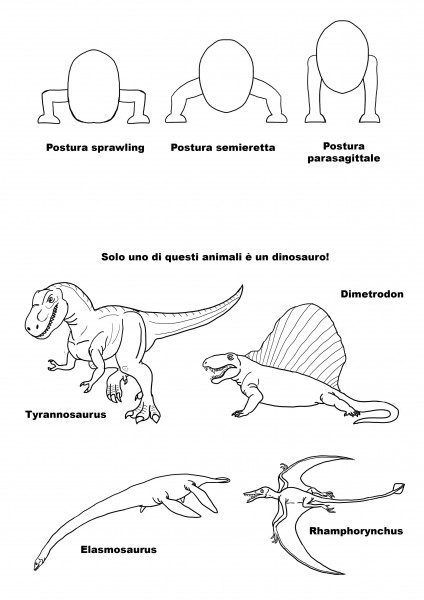Daniele Tona 24 marzo 2010
Questa domanda, apparentemente banale, è in realtà meno scontata di quel che sembra.
Il grande pubblico, infatti, tende a identificare col termine “dinosauro” qualunque rettile, possibilmente di grandi dimensioni, vissuto milioni di anni fa e oggi estinto. I dinosauri, però, sono solo uno degli innumerevoli gruppi di rettili che si sono avvicendati nel corso della storia del nostro pianeta.
Ci domandiamo a questo punto cos’è che definisce un dinosauro e lo distingue dagli altri rettili preistorici; per farlo noi possiamo valutare diversi elementi: l’epoca, l’ambiente di vita e l’anatomia di questi animali.
Iniziamo col considerare quando sono vissuti i dinosauri. Questi animali si sono evoluti durante l’era Mesozoica, dominando la Terra per un lasso di tempo molto lungo: ben 165 milioni di anni, dal Triassico superiore (circa 230 milioni di anni fa) alla fine del Cretaceo 65 milioni di anni fa, quando si verificò l’estinzione di massa che spazzò via loro e, non dimentichiamolo, molti altri gruppi di organismi.
Questo significa che, ad esempio, il famoso Dimetrodon dalla caratteristica vela sul dorso non è un dinosauro poiché è vissuto nel Permiano inferiore, molto tempo prima che il primo dinosauro facesse la sua comparsa; il dimetrodonte appartiene infatti ai Sinapsidi, il gruppo di rettili da cui si sono evoluti i mammiferi, e più precisamente fa parte dei loro esponenti più antichi denominati Pelicosauria; in altre parole, il dimetrodonte è parente più prossimo di noi umani che non del tirannosauro!
Lo stesso vale per i gruppi di rettili scampati alla crisi al limite tra Cretaceo e Paleogene, nessuno dei quali appartiene ai dinosauri; paradossalmente, la scoperta di Archaeopteryx nell’Ottocento ha suggerito che gli animali più vicini ad essi che oggi possiamo osservare in natura sono gli uccelli, ed i molti ritrovamenti negli ultimi decenni di dinosauri con caratteristiche affini a quelle degli uccelli lo hanno confermato.
All’interno del lasso di tempo che abbiamo definito non sono però esistiti solo i dinosauri.
Dobbiamo quindi adottare un altro criterio per restringere il campo, ed è quello dell’ambiente di vita: tutti i dinosauri sono animali esclusivamente terrestri; questo ovviamente non significa che non sapessero nuotare (al contrario: sono state rinvenute piste di impronte attribuite a dinosauri che mentre guadavano a nuoto uno stagno o un fiume grattavano il fondo con gli artigli), bensì che non avevano adattamenti anatomici che consentissero loro di colonizzare ambienti diversi dalla terra emersa. Questo esclude perciò tutti i rettili acquatici vissuti nel Mesozoico: gli Ittiosauri simili a pesci, i Plesiosauri dal collo lungo, i loro cugini Pliosauri ed i Mosasauri parenti stretti dei varani.
Se parliamo dell’ambiente aereo, però, il discorso si fa leggermente diverso: per gran parte del Mesozoico i cieli furono popolati dagli Pterosauri, rettili volanti caratterizzati da ali di pelle tesa dal quarto dito della mano; benché molti paleontologi considerino questi animali strettamente imparentati con i dinosauri, non vengono considerati parte di questo gruppo per tutta una serie di differenze anatomiche. Ciononostante, durante il Giurassico, circa 150 milioni di anni fa, gli Pterosauri furono affiancati dagli uccelli, che come abbiamo detto sono i diretti discendenti dei dinosauri.
Come facciamo quindi a distinguere questi ‘dinosauri’ volanti dagli Pterosauri?
Semplice: gli Pterosauri presentano il quarto dito estremamente allungato per sostenere l’ala, cosa che negli uccelli ancestrali non possiamo osservare.
Arrivati a questo punto abbiamo inquadrato dove e quando sono vissuti i dinosauri.
Sulla terraferma, però, vivevano molti altri rettili; come fare allora a distinguerli?
E’ qui che entra in gioco l’anatomia. Esistono molti caratteri che contraddistinguono i dinosauri e che si trovano solo in loro (il termine tecnico con cui chiamare tali caratteri è sinapomorfie), che però qui non tratteremo; ci basta sapere che il miglior modo per riconoscere un dinosauro è la sua postura.
Nei rettili possiamo infatti distinguere tre differenti posizioni degli arti rispetto al tronco: nella postura cosiddetta sprawling, che ritroviamo nelle lucertole odierne, l’omero (l’osso del braccio) e il femore (l’osso della coscia) si estendono in posizione quasi orizzontale, e gli arti si muovono in accordo con l’ondulazione laterale del corpo;
nella postura semieretta, che ritroviamo oggi nei coccodrilli e nei varani, gli arti fuoriescono con un angolo di circa 45 gradi, e il movimento serpentino del tronco è meno pronunciato; nella postura eretta o parasagittale, evoluta in modo del tutto indipendente dai dinosauri e dai Sinapsidi, gli arti sono disposti perpendicolari rispetto al corpo e risultano quindi posizionati sotto di esso anziché lateralmente.
Riassumendo, possiamo chiamare dinosauri tutti quei rettili vissuti tra 230 e 65 milioni di anni fa, unicamente sulle terre emerse (anche se poi avrebbero spiccato il volo) e caratterizzati, fra le altre cose, dagli arti direttamente sotto al corpo. Questi semplici elementi vi permetteranno di riconoscere un dinosauro quando vedrete un film o un documentario.

navigando ho visitato il vostro sito cercando qualche spunto.
Grazie!
Grazie a te e non smettere mai di cercare!
Alla prossima.
Stefano Rossignoli